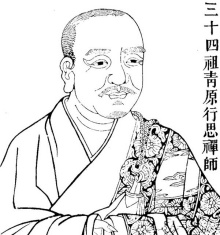Bodhidharma
Baizhang Huaihai
Caoshan Benji
Dahui Zonggao
Daman Hongren
Danxia Tianran
Dayi Daoxin
Dazhao Puji
Dazhu Huihai
Dazu Huike
Deshan Xuanjian
Dongshan Liangjie
Dōgen
Eisai
Guifeng Zongmi
Guishan Lingyou
Guizong Zhichang
Heze Shenhui
Hongzhi Zhengjue
Huangbo Xiyun
Huanglong Huinan
Huineng
Jinshan tanying
Linji Yixuan
Longtan Chongxin
Luohan Guichen
Mazu Daoyi
Nanquan Puyuan
Nanta Guangyong
Nanyang Huizhong
Nanyue Huairang
Niutou Farong
Qingliang Wenyi
Qingyuan Xingsi
Sengcan
Shishuang Chuyuan
Shitou Xiqian
Tianhuang Daowu
Xiangyan Zhixian
Xitang Zhizang
Xuansha Shibei
Xuedou Chongxian
Xuefeng Yicun
Yangqi Fanghui
Yangshan Huiji
Yantou Quanhuo
Yaoshan Weiyan
Yongjia Xuanjue
Yongming Yanshou
Yunmen Wenyan
Yunyan Tansheng
Yuquan Shenxiu
Zhaozhou Congshen
Index
Qingyuan Xingsi

born
671
died
740
died place
Qingyuan Mountain Ji'an
ACHV
ancestor of three of the Five Houses of Chan, Caodong/Sōtō, Yunmen/Unmon, and Fayan/Hōgen
religion
Chan
POSTH name
Chan Master Hongji
teacher
Dajian Huineng
students
Shitou Xiqian
Contents
Introduction
Biographical legends
Introduction
Qingyuan Xingsi (Chinese: 青原行思; pinyin: Qīngyuán Xíngsī) was a Zen Buddhist monk during the Tang Dynasty. Three of the five traditionally recognized houses of Zen are commonly believed to have developed out of his lineage: the Caodong/Sōtō, Yunmen/Unmon, and Fayan/Hōgen. There is scant information about his life. He is said to have lived in the Quiet Abode Temple on Mount Qingyuan. The Transmission of the Lamp claims he was Huineng's foremost student, although this was written during the Song Dynasty over 200 years after Qingyuan's death. In fact, in the oldest version of the Platform Sutra found among the Dunhuang manuscripts, which dates to about 850 CE, Qingyuan is not listed as a student of Huineng at all. The earliest source of information about Qingyuan comes from the Anthology of the Patriarchal Hall, which was completed in 952 by the monk Wendeng. The scholar Albert Welter suggests that Wendeng may have invented Qingyuan in order to legitimize Shitou Xiqian, Qingyuan's supposed student, and in turn himself since he was descended from Shitou. Shitou's original teacher, Huineng, died when Shitou was only 13, so Qingyuan was necessary for him to receive legitimate dharma transmission.
Biographical legends
As with most Tang Dynasty Zen monks, there are many vivid stories about Qingyuan's encounters with students and other teachers. They are almost certainly not historical events, however. The Transmission of the Lamp, for example, recounts the following:
When Shenhui of Ho Chen came to study with Qingyuan, the master asked where he was coming from, and Shenhui said from Cao Xi. "What's new in Cao Xi?" asked Qingyuan. When Shenhui remained silent, Qingyuan said, "Tiles and pebbles are still in your way". Shenhui asked, "Do you have true gold to give to others?" Qingyuan said, "Even if I had some, how would you hold on to it?"
Another from the same source takes place as follows:
Once a monk asked, "What is the main teaching of Buddhism?" Qingyuan replied, "What is the price of rice in Luling?"
Contact us
Disclaimer
Comments
© Copyright Jumpypixels.com